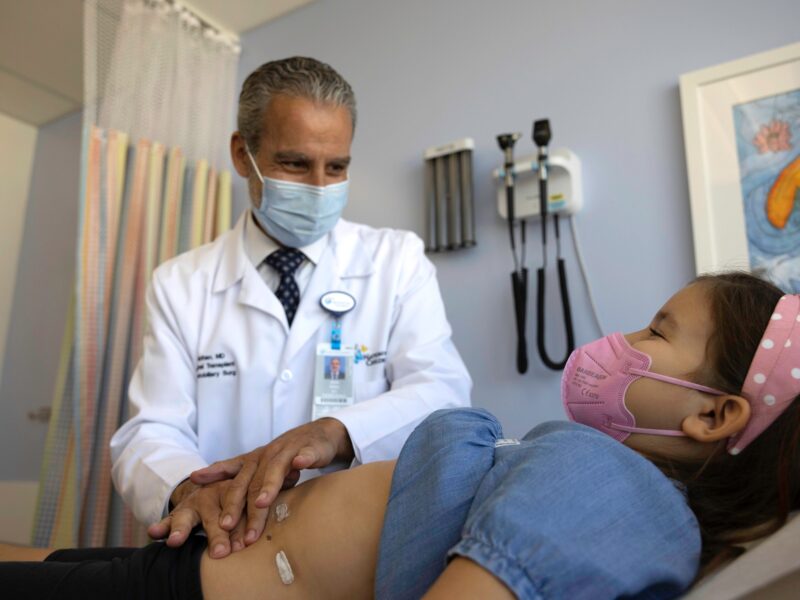New Ultrasound Technique for Monitoring Liver Disease
New Ultrasound Technique for Monitoring Liver Disease https://pediatricsnationwide.org/wp-content/themes/corpus/images/empty/thumbnail.jpg 150 150 Mary Bates, PhD Mary Bates, PhD https://secure.gravatar.com/avatar/c6233ca2b7754ab7c4c820e14eb518c8?s=96&d=mm&r=g- May 22, 2019
- Mary Bates, PhD
Liver disease is a concern for children with short bowel syndrome on long-term intravenous (IV) nutrition support. Now, a new study shows that ultrasound elastography is an accurate, noninvasive method to monitor for liver fibrosis in these patients.
Long-term IV nutrition support is necessary and life-saving for children with intestinal failure, such as those with short bowel syndrome due to necrotizing enterocolitis. But the treatment is not without risks. Long-term IV nutrition is one of the many factors that contributes to the development of liver disease in these patients. Routine monitoring of liver values with laboratory blood tests are standard in these patients, but these tests do not always accurately reflect the degree of liver disease. A liver biopsy is the gold standard for assessing liver disease, but it is an invasive procedure with risks of its own.
“We have been working on how to monitor these patients to know which ones are developing significant liver fibrosis versus those with low-grade inflammation and mild fibrosis,” says Peter Minneci, MD, MHSc, co-director of the Center for Surgical Outcomes Research at Nationwide Children’s Hospital and co-author of the new study.
Advances in ultrasound technology offer a new monitoring option: acoustic radiation force impulse (ARFI) ultrasound elastography. This is a non-invasive technique for looking at the elasticity of liver tissue, which correlates with the degree of fibrosis. ARFI ultrasound uses short duration, high-energy acoustic pulses and measures the shear waves in tissues that are stimulated in response. The speed of shear waves increases as tissue becomes more fibrotic.
In the new study, Dr. Minneci and Molly Dienhart, MD, attending physician in the Division of Gastroenterology, Hepatology and Nutrition at Nationwide Children’s, and colleagues evaluated whether ARFI ultrasound elastography of the liver in children with short bowel syndrome could help them differentiate between patients with mild fibrosis and those with more severe fibrosis.
At Nationwide Children’s, it is standard practice for children with short bowel syndrome requiring a follow up operative procedure to undergo a preoperative ultrasound and, when deemed safe by the surgeon, a liver biopsy during the procedure.
Dr. Minneci and his team analyzed the results of the ultrasounds and biopsies to see if elastography could distinguish between patients with mild and severe fibrosis of the liver.
“We found that ultrasound elastography is an accurate tool with a good ability to differentiate between mild and severe liver fibrosis in this pediatric population,” says Dr. Minneci, who is also associate professor of surgery and pediatrics at The Ohio State University College of Medicine.
“Looking at the 37 patients in this study, we found that there is a cut-off level in the elastography measurement that we can use to differentiate between mild fibrosis and more severe fibrosis. Our next step is a prospective validation of this cut-off value, which is ongoing at our institution,” says Dr. Dienhart, who is also an assistant professor of Clinical Pediatrics at OSU COM..
She adds that an “accurate, non-invasive method like ultrasound elastography would be clinically significant for children with short bowel syndrome.”
“We know this population is at risk for developing liver fibrosis,” Dr. Minneci says. “ARFI elastography could be used to identify a patient’s degree of liver disease, so those with mild fibrosis could be monitored over time with regular ultrasounds and those with elastography measurements more indicative of severe fibrosis could undergo a confirmation liver biopsy.
“In the long-run, ARFI elastography could allow us to monitor short bowel syndrome patients and minimize the number of invasive procedures they need.”
Reference:
Lawrence AE, Dienhart M, Cooper JN, Lodwick D, Lopez JJ, Fung B, Smith S, Warren P, Mezoff E, Balint J, Minneci PC. Ultrasound elastography as a non-invasive method to monitor liver disease in children with short bowel syndrome: Updated results. Journal of Pediatric Surgery. 2019 Mar 1. [Epub ahead of print]
About the author
Mary a freelance science writer and blogger based in Boston. Her favorite topics include biology, psychology, neuroscience, ecology, and animal behavior. She has a BA in Biology-Psychology with a minor in English from Skidmore College in Saratoga Springs, NY, and a PhD from Brown University, where she researched bat echolocation and bullfrog chorusing.
-
Mary Bates, PhDhttps://pediatricsnationwide.org/author/mary-bates-phd/December 27, 2016
-
Mary Bates, PhDhttps://pediatricsnationwide.org/author/mary-bates-phd/
-
Mary Bates, PhDhttps://pediatricsnationwide.org/author/mary-bates-phd/
-
Mary Bates, PhDhttps://pediatricsnationwide.org/author/mary-bates-phd/
- Posted In:
- In Brief





